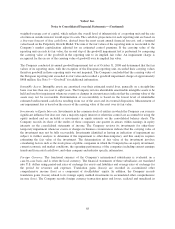Yahoo 2008 Annual Report Download - page 73
Download and view the complete annual report
Please find page 73 of the 2008 Yahoo annual report below. You can navigate through the pages in the report by either clicking on the pages listed below, or by using the keyword search tool below to find specific information within the annual report.Yahoo! Inc.
Notes to Consolidated Financial Statements—(Continued)
requirements. A portion of the Company’s cash is managed by external managers within the guidelines of the
Company’s investment policy. The Company’s investment policy limits the amount of credit exposure to any one
corporate issuer. Yahoo! protects and preserves invested funds by limiting default, market, and reinvestment risk.
To achieve this objective, the Company maintains its portfolio of cash and cash equivalents and short-term and
long-term investments in a variety of fixed income securities, including both government and highly rated
corporate obligations and money market funds. Accounts receivable are typically unsecured and are derived from
revenues earned from customers. The Company performs ongoing credit evaluations of its customers and
maintains allowances for potential credit losses. Historically, such losses have been within management’s
expectations. As of December 31, 2007 and 2008, no one customer accounted for 10 percent or more of the
accounts receivable balance and no one customer accounted for 10 percent or more of the Company’s revenues
for 2006, 2007, or 2008.
Property and Equipment. Buildings are stated at cost and depreciated using the straight-line method over the
estimated useful lives of 25 years. Leasehold improvements are amortized over the lesser of their expected useful
lives and the remaining lease term. Computers and equipment and furniture and fixtures are stated at cost and
depreciated using the straight-line method over the estimated useful lives of the assets, generally two to five
years. The Company recognized depreciation expense on property and equipment of approximately $302 million,
$409 million, and $509 million for 2006, 2007, and 2008, respectively.
Property and equipment to be held and used are reviewed for impairment whenever events or changes in
circumstances indicate that the carrying value of the assets may not be recoverable. Determination of
recoverability is based on the lowest level of identifiable estimated undiscounted future cash flows resulting from
the use of the asset and its eventual disposition. Measurement of any impairment loss for long-lived assets that
management expects to hold and use is based on the excess of the carrying value of the asset over its fair value.
No impairments of such assets were identified during any of the periods presented.
Internal Use Software and Website Development Costs. The Company capitalized certain internal use software
and Website development costs totaling approximately $84 million, $111 million, and $149 million during 2006,
2007, and 2008, respectively. The estimated useful life of costs capitalized is evaluated for each specific project
and ranges from one and a half to three years. During 2006, 2007, and 2008, the amortization of capitalized costs
totaled approximately $14 million, $48 million, and $81 million, respectively. Capitalized internal use software
and Website development costs are included in property and equipment, net. Included in the capitalized amounts
above are $14 million, $16 million, and $22 million, respectively, of stock-based compensation expense in the
years ended December 31, 2006, 2007, and 2008.
Goodwill. Goodwill represents the excess of the purchase price over the fair value of the net tangible and
intangible assets acquired in a business combination. In accordance with SFAS No. 142, “Goodwill and Other
Intangible Assets” (“SFAS 142”), goodwill is not amortized, but is tested for impairment on an annual basis and
between annual tests in certain circumstances. The performance of the goodwill impairment test involves a
two-step process. The first step involves comparing the fair value of the Company’s reporting units to their
carrying values, including goodwill. The Company’s reporting units are based on geography, either at the
operating segment level or one level below operating segments. The fair values of the reporting units are
estimated using an average of a market approach and an income approach as this combination is deemed to be the
most indicative of the Company’s fair value in an orderly transaction between market participants. In addition,
the fair values estimated under these two approaches are validated against each other to ensure consistency.
Under the market approach, the Company utilizes publicly-traded comparable company information, specific to
the regions in which the reporting units operate, to determine revenue and earnings multiples that are used to
value the reporting units adjusted for an estimated control premium. Under the income approach, the Company
determines fair value based on estimated future cash flows of each reporting unit discounted by an estimated
67
























